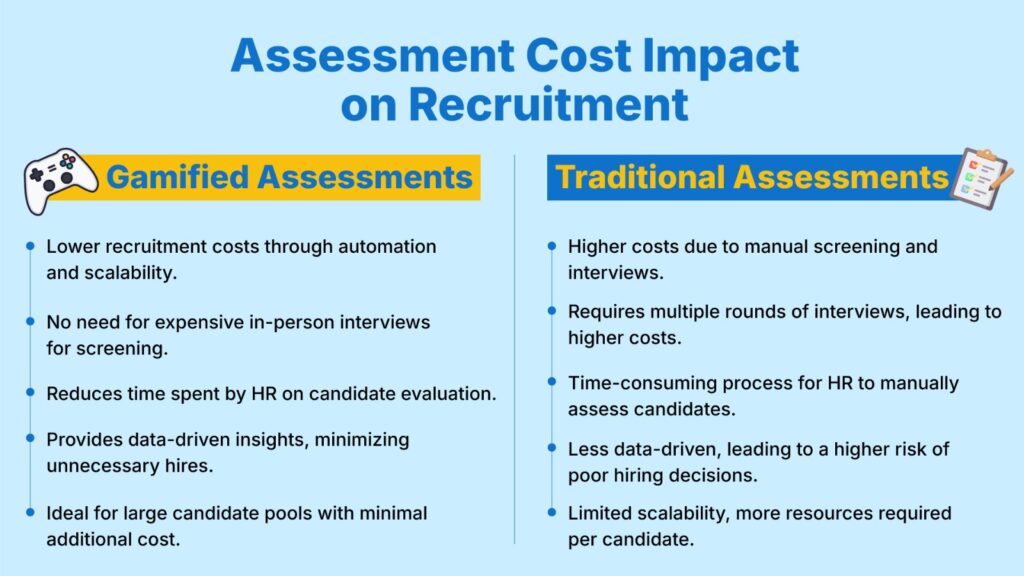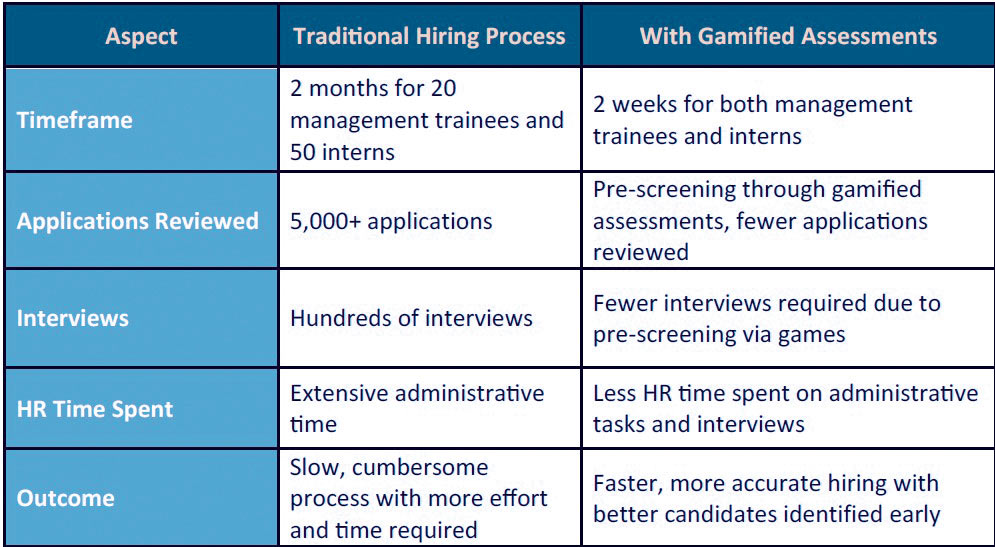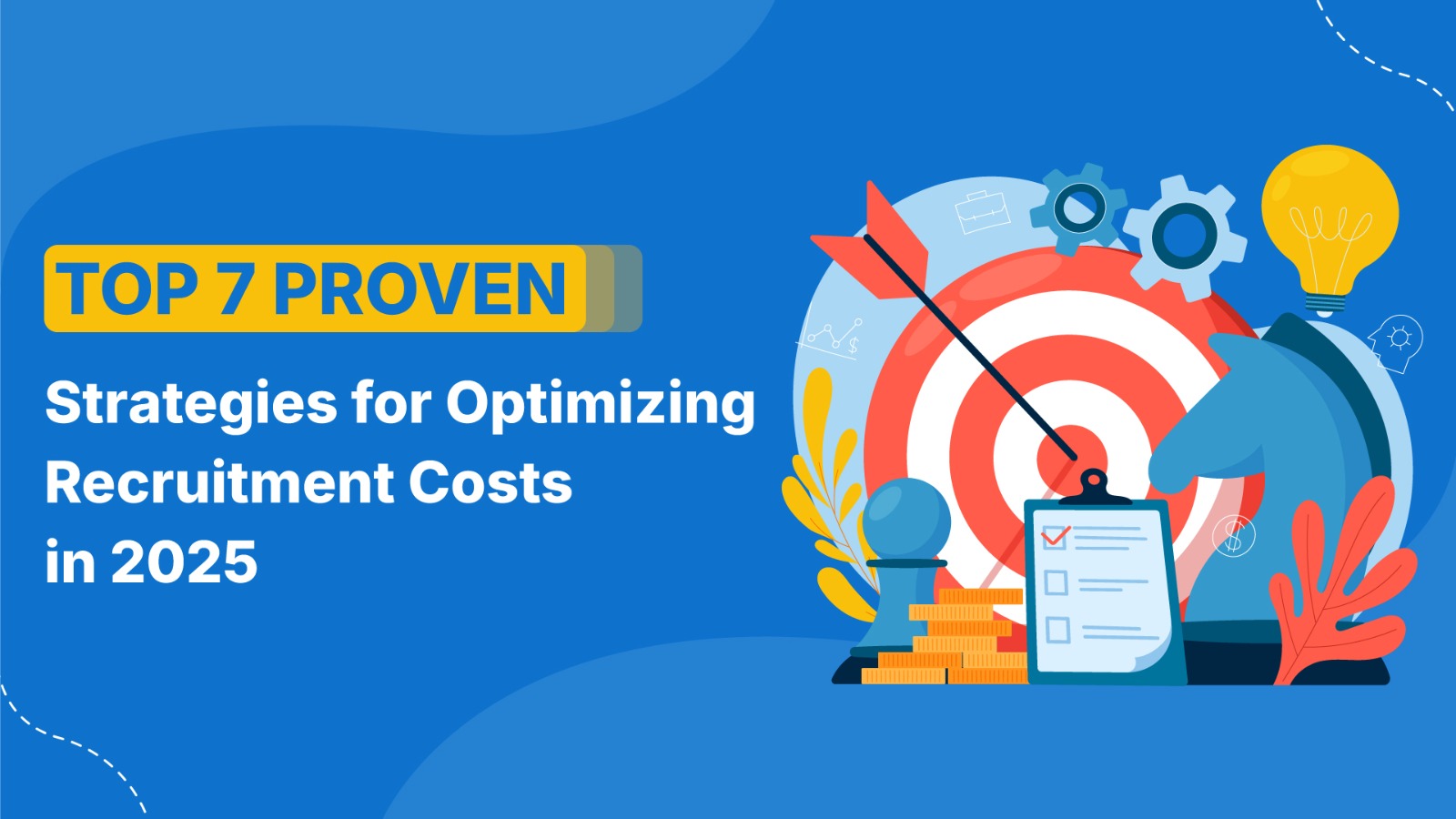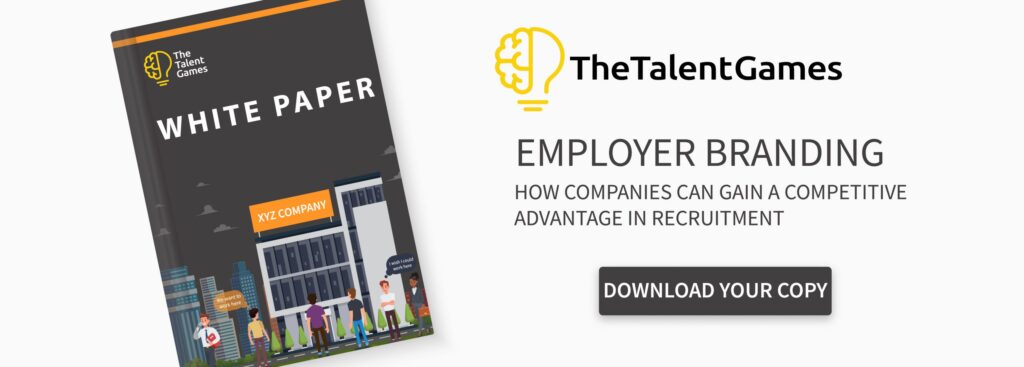Discover 7 effective ways to optimize recruitment costs in 2025 by leveraging the latest HR trends and innovative hiring solutions like gamified assessments.
Optimization of Recruitment cost is fundamental concern for the companies of all sizes. It involves the expenditures associated with overall hiring process such as attracting, sourcing, and hiring of new talent.
According to a study by SHRM, the average cost per hire in US is about $4000 to $4,700 which can become hefty for the companies that hire at bulk.
Moreover, the cost associated with bringing new employee onboard is even higher than the salary assigned to that position. This again as per SHRM, the turnover cost can reach as high as 150% of an annual salary of the employee.
In this blog we are going to find out the proven strategies that help you optimize your recruitment cost whether you have small organization or larger one. This will help you improve your bottom-line.
Let’s first explore the key factors that drive up the recruitment cost:

Source: Harver
What Factors Drive Up Recruitment Costs?
Recruitment costs can quickly add up, especially when a company is hiring frequently or in large numbers. There are several key factors that contribute to recruitment expenses, some of which are direct costs and others that are indirect but equally important.
Here are some common cost drivers:
• Advertising and Sourcing Expenses:
Posting jobs on multiple platforms, paying for targeted ads, and engaging external agencies can quickly add up. This includes costs for job boards, social media ads, and recruitment platforms.
• Assessment Tools:
Many traditional assessment tools, such as psychometric tests or interview scheduling platforms, come with high costs, especially when they are used at scale.
• Interviewing and Screening:
The process of organizing interviews, scheduling candidates, and conducting multiple rounds of screenings involves significant administrative and staff time.
• Onboarding Costs:
Beyond recruitment, bringing new employees onboard involves training materials, HR staff time, and even new equipment or software, which can significantly add to the overall cost of hiring.
7 Actionable Tips for Reducing Recruitment Costs
There can be many ways to make difference in the bottomline but here are the 7 key tips to get the maximum optimization on your recruitment cost:
1# Replacing Traditional Assessments with Gamified Assessments
The gamified assessments are the most trending way of not just saving on recruitment costs but also creating impact on various fronts such as employer branding, lowering turnover rate, reducing cost per hire and also reducing time to hire.

Gamified Hiring to Optimize Recruitment Costs
Gamified assessments are revolutionizing recruitment by offering a cost-effective, efficient, and engaging way to evaluate candidates. By replacing traditional methods with interactive tools that assess skills, thinking abilities, and job-related behaviors, companies can optimize recruitment costs and achieve significant savings.
Hiring costs typically include expenses for job postings, HR time, testing, interviews, and onboarding. For a $25,000 annual salary role, the traditional recruitment process can cost around $4,000. Gamified assessments streamline this process, reducing costs in key areas:
• Lower Recruitment Costs:
Fewer job postings, reduced HR involvement, and fewer interviews can save up to $7,650 per hire.
• Better Quality Hires:
Gamified tools effectively match candidates to roles, minimizing the risks and costs associated with poor hires, saving around $5,100.
• Faster Hiring:
By pre-screening candidates through games, the time-to-hire shrinks significantly, saving about $3,950.
• Reduced Turnover:
Employees hired through gamified assessments tend to stay longer, saving $10,500 in replacement costs.
With potential savings of over $27,000 per hire, gamified assessments offer a return on investment that not only cuts costs but also enhances hiring quality and efficiency, ultimately driving long-term business success.
The following chart elaborates the difference gamified tests can make on the budget-saving:

2# Optimize Recruitment Costs with Smart Automation
Efficiency is one of the fastest ways to bring hiring costs down. Instead of losing hours to scheduling emails or manual data entry, smart automation handles the repetitive work and keeps the process moving.
That gives your team the freedom to have real conversations with strong candidates and spot great fits early.
While the technology keeps things running, HR Datahub can supply live market benchmarks and pay-trend insights, helping you negotiate offers and plan head-count with confidence, all while keeping budgets under control. Here are the departments that you can automate:
• Automate Interview Scheduling
Tools that handle scheduling automatically can significantly reduce the back-and-forth of coordinating interviews, freeing up valuable time and ensuring smoother logistics.
• Use Pre-Screening Tools to Refine Candidate Pools
Incorporate engaging gamified situational judgment tests (SJTs) to evaluate candidates early in the process. These interactive assessments not only provide deeper insights into a candidate’s skills, behaviors, and decision-making abilities.
The gamified SJTs keep candidates engaged, offering a unique and enjoyable hiring experience. By focusing on job-relevant competencies, these tools eliminate the need for manual resume reviews and quickly identify high-potential candidates.
• Standardize and Digitalize Interviews
Having a structured interview process helps ensure every candidate gets a fair shot while making evaluations more consistent.
Pair this with tools like video interviews, and you can speed things up without losing the human element. It’s a smart way to save time and money while still connecting meaningfully with potential hires.
3# Capitalize on Employee Referral Programs
Employee referrals are one of the most cost-effective ways to source quality candidates. When your employees refer someone, it often means that the person is a better cultural fit and has already been vetted through an internal network. This can dramatically reduce your hiring costs compared to sourcing candidates externally.
Here are a few advantages of referral programs:
• Lower sourcing costs:
Compared to recruitment agencies or traditional job ads, referral programs significantly cut expenses. Instead of paying hefty agency fees (e.g., 15% of a $70,000 salary = $10,500), offering a referral bonus of $100 to $5,000 is far more cost-efficient.
• Higher-quality candidates:
Referred employees tend to excel in both skills and cultural fit, often resulting in longer tenures. Studies show that referred hires typically stay with the organization longer than those from other sourcing methods.
To optimize your referral program, design clear incentive structures, such as cash bonuses or additional perks, to encourage participation. Not only will this reduce hiring costs, but it will also empower your team to actively contribute to building a strong and cohesive workforce.
4# Craft Targeted Job Ads to Attract the Right Talent
Job ads can quickly become a drain on recruitment budgets if not managed strategically. Instead of relying on costly job boards or mass outreach platforms, consider leveraging social media ads to target specific candidate profiles.
Social media platforms like LinkedIn, Facebook, and Instagram allow you to narrow your audience based on skills, location, and industry, ensuring your ad reaches the most relevant talent. This precision not only improves the quality of applicants but also minimizes ad spend.
Here are a few key tips for cost-effective job ads:
• Write concise, focused job descriptions:
Clearly outline the skills and experience required for the role to attract only qualified candidates and reduce irrelevant applications.
• Leverage social media ads:
Platforms with advanced targeting capabilities are a cost-effective alternative to broad job boards, providing better results for less money.
By using targeted ads and analytics, you can attract the right talent while keeping expenses in check, helping to optimize recruitment costs and streamline your hiring process.
5# Leverage AI Recruitment Softwares for Accurate Hiring
AI has revolutionized the recruitment process by automating tasks that were previously time-consuming and prone to human error. By integrating AI tools, companies can make faster, more accurate hiring decisions, ultimately reducing recruitment costs.
AI can help in various ways:
• Automated resume screening:
AI-powered ATS tools can quickly scan resumes for specific keywords and qualifications, drastically reducing the time recruiters spend manually reviewing applications.
• Chatbots for candidate communication:
Chatbots can be programmed to answer common candidate questions, provide updates on application status, and even conduct preliminary screening conversations, helping recruiters save time.
• Data-driven insights
AI can analyze past recruitment data to identify candidates most likely to succeed, enabling hiring teams to focus on top talent and optimize recruitment costs.
6# Focus on Employer Branding to Reduce Hiring Expenses
Strong employer branding plays a crucial role in reducing recruitment costs up to 43%. When candidates are already familiar with your company and view it positively, they are more likely to apply, reducing the need for expensive advertising or recruitment campaigns.
Few of the branding that help reducing cost include:
• Showcase company culture on social media:
Sharing content about your work environment, values, and employee experiences can build a positive image of your company, making it more attractive to potential candidates.
• Publish employee testimonials:
Real stories from current employees can provide insight into your company’s culture and work-life balance, which can resonate with candidates and attract those who fit your values.
A strong employer brand not only attracts quality talent but also reduces the need for aggressive recruitment advertising, saving you money in the long run.
7# Shift to Remote Interviews and Virtual Assessments
In recent years, remote hiring has become the norm, and for good reason. Virtual interviews and assessments are not only more convenient but also significantly reduce hiring costs.
Here’s how remote recruitment can save you money:
• Save on travel and logistical expenses:
There is no need for candidates and recruiters to travel, which reduces costs associated with transport, accommodation, and time spent on in-person meetings.
• Broaden your talent pool:
Virtual recruitment opens up opportunities to hire from a wider, global talent pool. This increases the likelihood of finding the best fit for your organization without the geographical limitations of traditional hiring.
• Enhance candidate experience:
Remote assessments are a great way to engage candidates from the start while also streamlining the evaluation process. They allow you to assess skills in real-time, reducing time-to-hire costs.
Shifting to virtual hiring strategies, your company not only saves money but also improves candidate experience, making it a win-win for both sides.
Final Thoughts:
Reducing recruitment costs allows you to allocate resources more efficiently, enhance hiring processes, and boost overall business performance.
By using tools like gamified assessments, you can optimize recruitment costs, streamline hiring, and attract Gen Z talent—the workforce of 2030—while achieving long-term cost savings.

